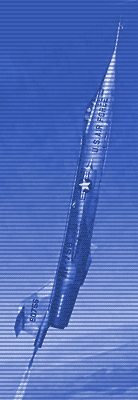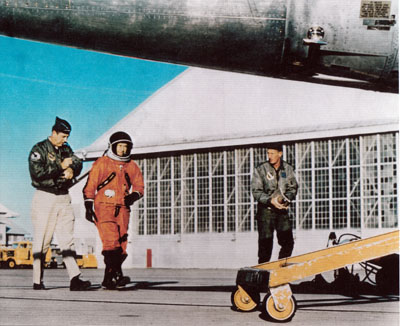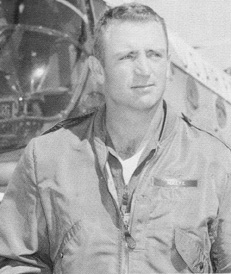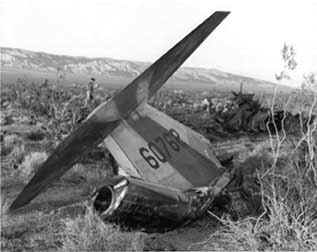The Mission > home

|
|
|
|
|
|
 |
The Mission click on the links below for more of the story...
|
||||||
12 Spin, Crash & RescueChuck made another max zoom attempt in the afternoon of December 10, 1963, a disastrous day for the project and almost a deadly one for him. In the morning he appeared to have the same difficulties he had on previous tries, falling back far below the altitude he needed for the record.
He scheduled himself twice that day, and in fact if not in writing, the airplanes now belonged to his school. I again briefed him and could only repeat that he would have certainly gone considerably higher that morning, if he were pulling up promptly with 3.5 g and maintaining 70-degrees to the null angle of attack. The morning flight clearly showed he tried too late in the ascent to increase his climb angle, like he had overlooked it again at first. I tried to reinforce the techniques for RCS control from there, over-the-top and down to the point of reentry, though I had no definitive indication he had that problem, just a hunch because of its uniqueness, and his seeming lack of interest in that particular line of briefing. This time Chuck did only slightly better flying to about 108,000 feet, that according to his biography. I did not see the radar plot on that flight because it was impounded for the accident board. I remember some information was passed along by folks involved in the accident investigation that reviews of aircraft instrument data proved he was at risk of the same thing happening on his earlier zoom attempts, including that morning. The board’s technical adviser, Major Art Torosian, himself a graduate of the test pilot school and a graduate degree in dynamics from the California Institute of Technology, provided me insight on the facts, reinforced by comments of some of the engineering folks of the Test Directorate. Art later graduated with the Class IV of ARPS, the last class, of that school. I had been monitoring Chuck’s flights from the radio in test operations but in this particular case Al Crews was to fly a two seat 104B, with me in the back, and we would listen in, airborne. We had such a violent nose-wheel shimmy that he had to abort take-off, so I hastened to our ground radio in test operations. Chuck was in the zoom and announced that he was in a spin.
I contacted Phil Neale, a test pilot and our helicopter flyer, and we scrambled to the H-21 chopper parked in front of operations. We headed for the point we knew from the flight plan, discovered that Bud Anderson, a leading Ace from WWII and Chuck’s best buddy, was airborne by chance and had Chuck in view and Phil got precise directions. I have many vivid recollection of that event including Chuck’s report of the flat spin, which incidentally is a slow descent, compared to a dive or normal spin. He was coolly reciting the very low engine rpm, still rotating from some airflow through the ducts, even though it had burned out long before, in his ascent. In fact, Bud followed him down in the parachute, after bailout and assured that he landed safely, while Phil and I were en-route to the site. Bud called that he had to depart shortly before we arrived because of fuel state, but believed Chuck was O.K. because he waved at Bud after he was on the ground.
As we approached the accident scene, we could see Chuck standing close to the hulk of the airplane, which appeared to have been dropped from high onto its belly. There was no sign of fire, just a bit of wispy white vapor, which could have been from the H2O2 tank of the RCS or a little residual from the main rocket tank, though unlikely, since it virtually emptied at 70-degree climb, by design. I hurried aft, opened the large door on the side and put down the ladder, as we landed. Chuck started to walk toward us in his pressure suit, but with helmet in hand. I jumped down and ran to him and was shocked by his condition. One half of his face was solidly charred into a deep black, with a few strips of blood red. It appeared to me that his skin had literally been burned off, with only some pieces of flesh hanging on. I started assisting him the short distance to the chopper, when he suddenly turned and said he wanted his kneeboard (used for test notes by the pilots) then he said he had taken it off and placed under the windshield before he bailed out. I tried to dissuade him, but couldn’t and sure enough it was right where he said. He didn’t have to climb, just step up and reach in without any landing gear between belly and ground. His having that recall of his actions at such a moment was a memory I have never forgotten, because it characterized Chuck Yeager under duress. I was terribly concerned by his appearance, and Phil notified the hospital. Only much later after hearing the results from the medical doctors’ work and the results of the accident analysis, was I to realize my impression was an optical illusion …the very deep black and bright red had reversed the image. In fact the black was fused rubber from the burned helmet imposed upon his skin and what appeared as dangling threads of remaining tissue, were tears in the char, as the metal attaching ring at the bottom of the helmet tore skin when he pushed it off, over his head. Later, investigation proved that the fire occurred when the visor was shattered from impact with the tail end of the solid rocket, which propelled the ejection seat clear of the aircraft. In normal ejection the seat was propelled out of the cockpit by a rocket tube on back and at its burnout the next event was automated release of the straps holding the pilot, then a “butt snapper” provided separation of the seat and pilot. Usually windblast caused further clearance from the seat, but in his flat spin, Chuck and the seat were falling together. The end of the rocket tube, with its residual fire typical of a solid motor, just happened to fly by and knocked out his helmet visor. In the process it ignited a blaze of burning rubber, inside. The fire was exceptionally hot, automatically fed by pure oxygen from the bottle attached to Chuck’s parachute for high altitude bailouts. I remember well that Chuck told me he thought his chute was on fire, as Phil flew us to the hospital, and said he held his hand inside to protect his eyes, so he must not have understood the source of ignition. Therefore, he may not have thought to open his broken visor and stop the oxygen feed directly onto his burned skin, though his autobiography says he did. Quite frankly, I know I wouldn’t have thought of opening the broken faceplate to shut off the oxygen supply under such duress, but I’ll grant he was a cool customer that day. As we returned toward the base hospital, I remained with Chuck in the rear and he talked some, though he was in a lot of pain, especially his hand. When he described the burning within the helmet and said he thought his parachute was on fire, it was the only statement that he made during our return that seemed questionable to me. I couldn’t imagine him surviving descent in a burning chute and not be injured by the landing. He still had his glove on so I couldn’t see the hand that was hurting so bad. That is what reinforced that statement in my memory. We arrived at the hospital and the Commander, Col. Stan Bear, M.D. and a medical team were waiting for him. Chuck’s circle of friends and his importance was impressive, again. From the time he reported the spin, until we got him out of the chopper, could have been an hour, not much more, I believe, just based on the events and estimated distances. When he got out of the chopper I remember someone, I think it was Stan, saying that General LeMay and Jackie Cochran had both called earlier and were awaiting immediate information on his condition. This was a memorable experience, and unique event in my life and, as such, one that I have related to friends over the years, so it stayed fresh in my mind, a very salient point as I discuss this event in the full context of the AST Project. Subsequent to his accident, Chuck went to Jackie Cochran’s ranch for rest. It was a place he enjoyed with Jackie and Floyd, and a place where at least two Presidents, Truman and Eisenhower had hung out. When he returned, still on recuperation, I paid him a visit, at his home on base. He told me that after his accident he asked Gen. LeMay to permit me to go for the record. That was unsolicited, and it was the only time I ever heard of that possibility. Luckily, it never made me hold my breath. Chuck gave me a present that day for my daughter, Lane, that was her prized possession, and a wonderful family pet. Chuck, one of the most avid hunters and fishermen I’ve known, had found the pregnant mother in the wild. A beautiful California Golden Chipmunk, just weaned in Chucks atrium, who became a uniquely inquisitive member of the household, allowed free reign and roam at home. Chipper had his own little cage, open much in daylight, where he so carefully stacked sunflower seeds, so perfectly that it was an engineering feat. He would spend hours stuffing whole Kleenex into his mouth and shred them by pulling strips through the two front teeth to remake his fluffy cave. Often on week-ends, when he was out and playing with us in the house, sitting on shoulders or heads, he would tire and we would find him napping inside a drawer of Lane’s dresser, where the articles were the softest. And he was perfectly and naturally house broken to his cage. Something else occurred that could only happen to Chuck Yeager, the most recognized modern pilot and the holder of so many awards and recognitions for his flying exploits. It is all the more ironic since it was so clear that he was determined to make this his one more and last world record and only one he ever failed on, as far as I know. Shortly after this accident a civilian parachuting association invited him to receive a special award they presented for making a successful emergency jump from the highest flight, a presentation that was reported in the news. |
| previous section | next section |


